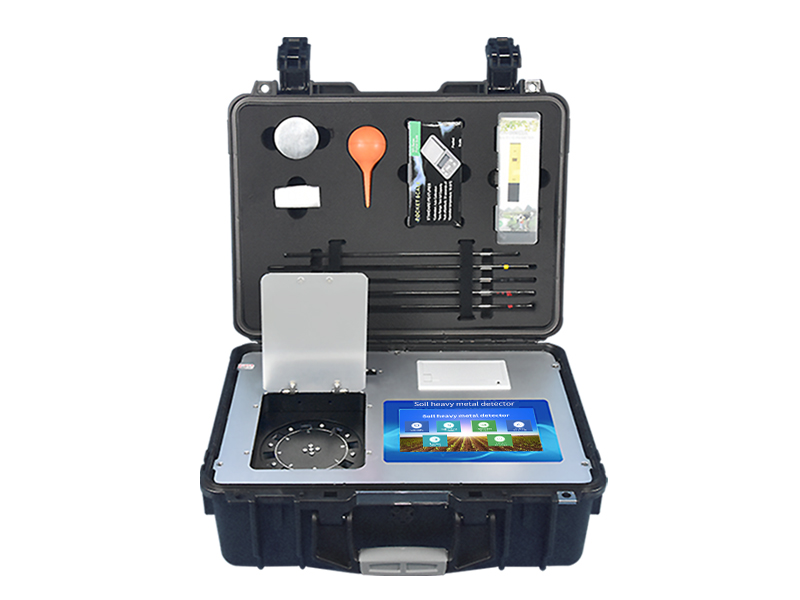Heavy metal pollutants such as lead, cadmium, and mercury may be hidden in the soil. These pollutants not only affect crop growth, but may also enter the human body through the food chain, posing a threat to health. The emergence of soil heavy metal detectors provides technical support for safeguarding land safety, ensuring agricultural production, and human health.

The technical advantages of soil heavy metal detectors are very prominent, reflecting professionalism and efficiency in both hardware and software. In terms of hardware, it integrates various functions into one, without the need for users to customize accessories, and can flexibly conduct mobile testing. Whether in the field or laboratory, it can easily carry out work. It is equipped with the Android operating system, and the main control chip adopts ARM Cortex-A7, RK3288/4-core processor, with a main frequency of 1.88GHz, which makes the instrument run faster and more stable, and can handle large amounts of data processing with ease.
In terms of detection efficiency, the solid-state design of the 6 detection channels allows it to quickly detect 6 samples at once, greatly improving detection efficiency and reducing detection costs. For users who need to test soil samples in bulk, this is undoubtedly a great blessing. Moreover, the built-in calibration function during the detection process, intelligent constant current and voltage stabilization, and automatic calibration of light intensity can ensure the accuracy of detection, making every detection result reliable and trustworthy.
In terms of optical performance, the 4-wavelength professional test cold light source (red, blue, green, orange) performs well, with stable light source wavelength, no temperature drift phenomenon during long-term continuous operation, a lifespan of up to 100000 hours, good reproducibility, and high accuracy. The colorimetric cell adopts a standard 1cm colorimetric dish with no mechanical displacement or wear. The optical path testing positioning effectively shields external light interference, ensuring that the detection results are better than the national standard requirements, and providing technical support for the detection accuracy.
The software functions are equally powerful, and the instrument has a built-in crop expert fertilization system that can calculate recommended fertilization amounts for over a hundred national agricultural economic crops, fruit trees, and other target yields, and scientifically guide agricultural production based on fertilization formulas. The results of soil testing formula fertilization can be printed, including crop types, fertilizer types, target yields, total demand, and recommended fertilization plans. This allows users to understand the heavy metal situation in the soil while also receiving scientific fertilization guidance.
Data transmission and management are also very convenient. The instrument comes standard with WiFi wireless upload, 4G network transmission, and GPRS wireless remote transmission functions, which can quickly upload data. It also has USB and Ethernet interfaces, and can copy data from a USB flash drive at any time to meet the data transmission needs in different scenarios. Built in large capacity memory, supports viewing all historical detection records and transferring all detection data. Equipped with a smart cloud agriculture platform, the instrument can be connected to a wireless network to selectively or batch upload detection data wirelessly, making it convenient for users to conduct long-term data management and visual analysis. What's even more considerate is that users can log in to the cloud platform online at any time with their mobile phones to view historical data and keep track of soil testing dynamics anytime, anywhere. In addition, the instrument is equipped with a plant nutrition diagnostic standard map, which compares the nutrient deficiency images of various crops on the leaf surface to diagnose abundance and deficiency, providing comprehensive guidance for crop growth.
Soil heavy metal detectors have a wide range of applications. In agricultural production, it can detect the heavy metal content in farmland soil, determine whether the soil is suitable for crop planting, and provide guarantees for the development of green agriculture; In the field of environmental protection, soil in polluted areas can be monitored to assess the degree of pollution and provide data support for soil remediation; In geological exploration, it can assist in understanding the distribution of heavy metals in soil and provide reference for geological research.
Currently, there are some pain points in the soil testing industry, such as low testing efficiency and difficulty in meeting the demand for batch sample testing; The accuracy of the detection data is not high, which affects subsequent decision-making; Data management is inconvenient and not conducive to long-term analysis. The soil heavy metal detector has provided effective solutions for these pain points. Its multi-channel design improves detection efficiency; The built-in calibration function ensures the accuracy of the detection data; Multiple data transmission and management methods facilitate users' long-term management and analysis of data.
In practical applications, there are many successful cases. A certain green vegetable planting base has introduced soil heavy metal detectors to ensure vegetable quality. By regularly testing the soil of the base, we can timely grasp the changes in heavy metal content in the soil. Once any exceedance is found, corresponding improvement measures should be taken immediately. With the assistance of soil heavy metal detectors, the quality of vegetables grown in this base has been effectively guaranteed, winning market recognition and increasing sales year by year.
In short, soil heavy metal detectors have become important equipment in the field of soil detection due to their advanced technology, wide application, and significant effectiveness. It provides strong support for us to understand the situation of heavy metals in soil and ensure land safety. Whether it is agricultural producers, environmental workers, or researchers, they can all receive practical help from it. Choosing a soil heavy metal detector is to add a guarantee to land safety and contribute to the sustainable development of agriculture.
Article address:https://www.soiltesting.cn/news1/118.html






